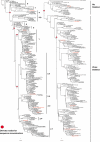Feasibility of reconstructed ancestral H5N1 influenza viruses for cross-clade protective vaccine development
- PMID: 21173241
- PMCID: PMC3017181
- DOI: 10.1073/pnas.1012457108
Feasibility of reconstructed ancestral H5N1 influenza viruses for cross-clade protective vaccine development
Abstract
Since the reemergence of highly pathogenic H5N1 influenza viruses in humans in 2003, these viruses have spread throughout avian species in Asia, Europe, and Africa. Their sustained circulation has resulted in the evolution of phylogenetically diverse lineages. Viruses from these lineages show considerable antigenic variation, which has confounded vaccine planning efforts. We reconstructed ancestral protein sequences at several nodes of the hemagglutinin (HA) and neuraminidase (NA) gene phylogenies that represent ancestors to diverse H5N1 virus clades. By using the same methods that have been used to generate currently licensed inactivated H5N1 vaccines, we were able to produce a panel of replication competent influenza viruses containing synthesized HA and NA genes representing the reconstructed ancestral proteins. We identified two of these viruses that showed promising in vitro cross-reactivity with clade 1, 2.1, 2.2, 2.3.4, and 4 viruses. To confirm that vaccine antigens derived from these viruses were able to elicit functional antibodies following immunization, we created whole-virus vaccines and compared their protective efficacy versus that of antigens from positive control, naturally occurring, and broadly reactive H5N1 viruses. The ancestral viruses' vaccines provided robust protection against morbidity and mortality in ferrets challenged with H5N1 strains from clades 1, 2.1, and 2.2 in a manner similar to those based on the control strains. These findings provide proof of principle that viable, computationally derived vaccine seed viruses can be constructed within the context of currently licensed vaccine platforms. Such technologies should be explored to enhance the cross reactivity and availability of H5N1 influenza vaccines.
Conflict of interest statement
The authors declare no conflict of interest.
Figures



References
-
- Yen HL, Webster RG. Pandemic influenza as a current threat. Curr Top Microbiol Immunol. 2009;333:3–24. - PubMed
-
- Xu X, Subbarao, Cox NJ, Guo Y. Genetic characterization of the pathogenic influenza A/Goose/Guangdong/1/96 (H5N1) virus: Similarity of its hemagglutinin gene to those of H5N1 viruses from the 1997 outbreaks in Hong Kong. Virology. 1999;261:15–19. - PubMed
-
- Organisation for Animal Health (OIE) Outbreaks of Highly Pathogenic Avian Influenza (Subtype H5N1) in Poultry. From the End of 2003 to 17 June 2010. 2009. Available at http://www.oie.int/downld/AVIAN%20INFLUENZA/Graph%20HPAI/graphs%20HPAI%2... Accessed October 15, 2010.
-
- World Health Organization. Global Alert and Response: Avian Influenza. Cumulative Number of Confirmed Human Cases of Avian Influenza A/(H5N1) Reported to WHO. 2010. Available at http://www.who.int/csr/disease/avian_influenza/country/cases_table_2010_.... Accessed October 15, 2010.
Publication types
MeSH terms
Substances
Associated data
- Actions
- Actions
- Actions
- Actions
- Actions
- Actions
- Actions
- Actions
Grants and funding
LinkOut - more resources
Full Text Sources
Other Literature Sources
Medical

